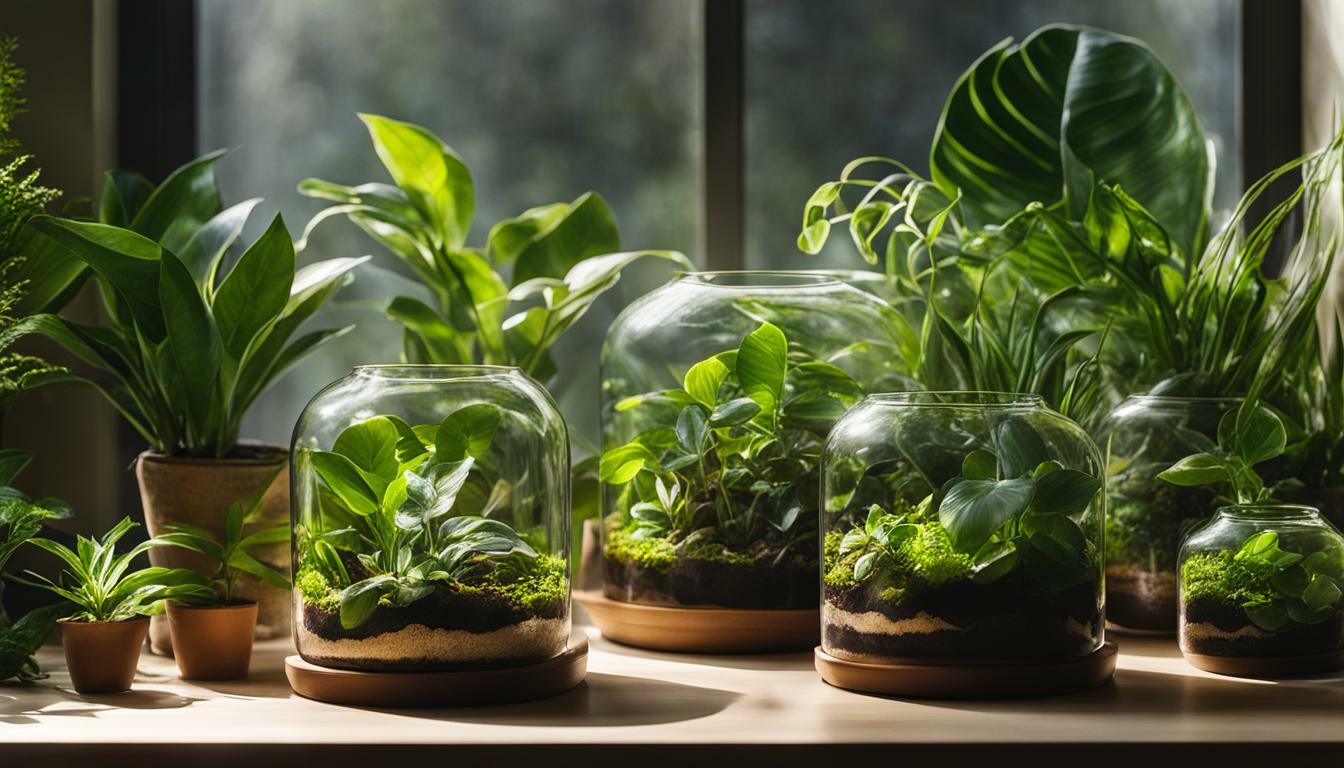Welcome to our comprehensive guide to terrarium plants, with a special focus on prayer plants. If you’re an indoor gardening enthusiast looking to create a lush and vibrant terrarium, prayer plants are an excellent choice. These tropical plants, also known as Maranta leuconeura, are native to South America and feature stunning deep green foliage with rich purple undersides. One of their most unique characteristics is that their leaves fold up at night, resembling praying hands.
- Terrarium plants, specifically prayer plants, are popular choices for indoor gardening.
- Prayer plants have deep green foliage and rich purple undersides, with leaves that fold up at night.
- They prefer medium to high light intensity and thrive in moist, well-drained soil with a mildly acidic pH level.
- Prayer plants can be used in both foreground and background positions in a terrarium and look best along the edges and top of hardscapes.
- Other plant options for terrariums include ferns, foliage plants, vines, and epiphytes.
What are Terrarium Plants Prayer Plants?
The Maranta leuconeura, also known as the prayer plant, is a popular choice for terrariums. This tropical plant is native to South America and features stunning deep green foliage with rich purple undersides. One of its unique characteristics is that the leaves fold up at night, resembling praying hands, which gives it its distinctive name.
The prayer plant typically grows to be around 6 to 12 inches in height and thrives in medium to high light intensity. It is best suited for moist, well-drained soil with a mildly acidic pH level. When placed in a terrarium, prayer plants can be used in both foreground and background positions, but they look especially appealing when positioned along the edges and top of hardscapes.
| Key Points: |
|
|---|
When caring for a prayer plant, it is important to provide regular, moderate watering and avoid overwatering. These plants appreciate a humid environment, so misting the leaves occasionally can help maintain the desired level of humidity. If you’re looking for alternative plants to use in your terrarium, ferns, foliage plants like Peperomia and Calathea, vines like Selaginella and Ficus pumila, or epiphytes like Tillandsia are all suitable options.
Prayer Plant Care Tips:
- Regular, moderate watering is necessary to keep the soil evenly moist.
- Avoid overwatering, as it can lead to root rot.
- Mist the leaves occasionally to provide the desired level of humidity.
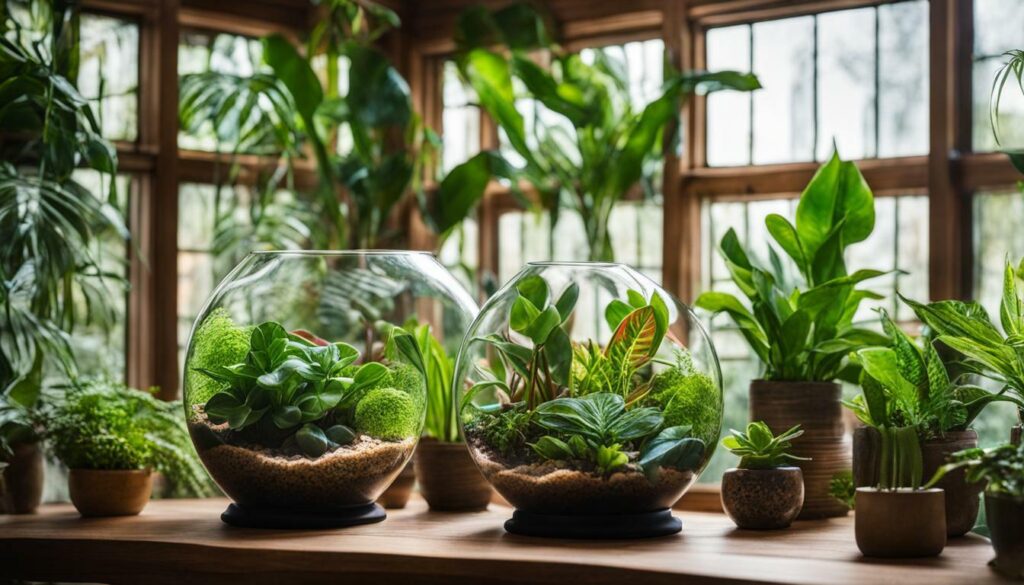
In conclusion, prayer plants are an excellent choice for adding vibrant foliage to your terrarium. Their unique folding leaves and tropical appearance make them a visually appealing addition to any indoor garden. Remember to provide them with the proper growing conditions and care to ensure their health and longevity in your terrarium. Consider exploring alternative plants and experimenting with different placements to create a diverse and thriving terrarium display.
Growing Conditions for Terrarium Plants Prayer Plants
The Maranta leuconeura, also known as the prayer plant, is a popular choice for terrariums. This tropical plant, native to South America, features stunning deep green foliage with rich purple undersides. The leaves of the prayer plant fold up at night, resembling praying hands. It grows to be approximately 6 to 12 inches in height and prefers medium to high light intensity.
When it comes to growing conditions, the prayer plant thrives in moist, well-drained soil with a mildly acidic pH level. It is essential to provide regular, moderate watering, ensuring the soil remains consistently moist but not overly saturated. Overwatering can lead to root rot and other issues.
| Lighting | Soil | Watering |
|---|---|---|
| Medium to high light intensity | Moist, well-drained soil | Regular, moderate watering |
Prayer plants can be used in both foreground and background positions within a terrarium. To enhance their aesthetic appeal, they look best when placed along the edges and top of hardscapes, creating a captivating visual display.
If you’re considering alternative plants for your terrarium, ferns, foliage plants like Peperomia and Calathea, vines like Selaginella and Ficus pumila, and epiphytes like Tillandsia make great substitutes for the prayer plant. These plants bring their unique characteristics, adding diversity and charm to your indoor garden.
Remember, each plant has its specific care requirements. By understanding the ideal growing conditions for prayer plants and other alternatives, you can create a thriving terrarium garden that brings nature’s beauty into your home.
Summary:
- The Maranta leuconeura, or prayer plant, is a tropical plant native to South America that is popular for terrariums.
- It prefers medium to high light intensity and moist, well-drained soil with a mildly acidic pH level.
- Regular, moderate watering is essential for its care.
- Prayer plants can be used in both foreground and background positions in a terrarium and look best along the edges and top of hardscapes.
- Alternative options for prayer plants include ferns, Peperomia, Calathea, Selaginella, Ficus pumila, and Tillandsia.
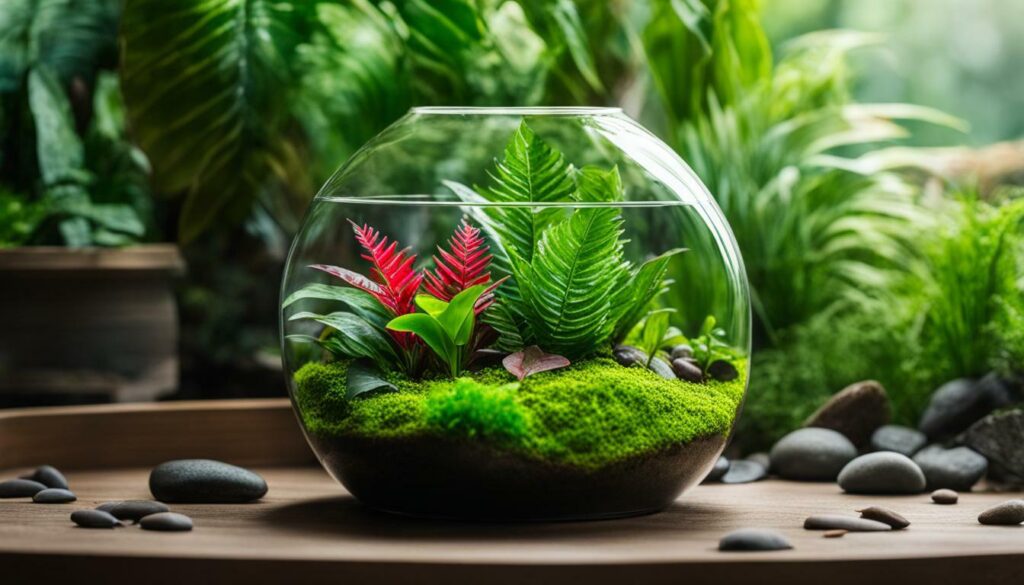
The Maranta leuconeura, also known as the prayer plant, is a popular choice for terrariums. This tropical plant, native to South America, features stunning deep green foliage with rich purple undersides, adding a vibrant touch to any indoor garden. One of the unique characteristics of the prayer plant is its leaves, which fold up at night, resembling praying hands.
When incorporating prayer plants into your terrarium, it is important to consider their ideal growing conditions. Prayer plants thrive in medium to high light intensity, so placing them in areas with access to natural light or using artificial grow lights can help ensure their optimal growth. They also prefer moist, well-drained soil with a mildly acidic pH level.
| Plant Care Tips: |
|---|
| Provide regular, moderate watering, avoiding overwatering that can lead to root rot. |
| Maintain humidity levels by misting the leaves or placing a humidity tray near the terrarium. |
| Prune the plant regularly to maintain its compact shape and promote healthy growth. |
In terms of placement within the terrarium, prayer plants can be used in both foreground and background positions. To create an aesthetically pleasing display, consider placing them along the edges and top of hardscapes, allowing their vibrant foliage to cascade down and provide an eye-catching focal point.
If you’re looking for alternatives to prayer plants, there are several options. Ferns, such as Boston fern and maidenhair fern, offer a lush and delicate appearance. Foliage plants like Peperomia and Calathea bring unique patterns and textures to the terrarium. Vines like Selaginella and Ficus pumila can be used to create cascading greenery, while epiphytes like Tillandsia add a touch of elegance with their air plant characteristics.
Expert Tip:
“When designing your terrarium, consider the overall composition and balance of plants. Prayer plants can serve as focal points, but don’t be afraid to mix different varieties for a more dynamic and visually appealing display.”
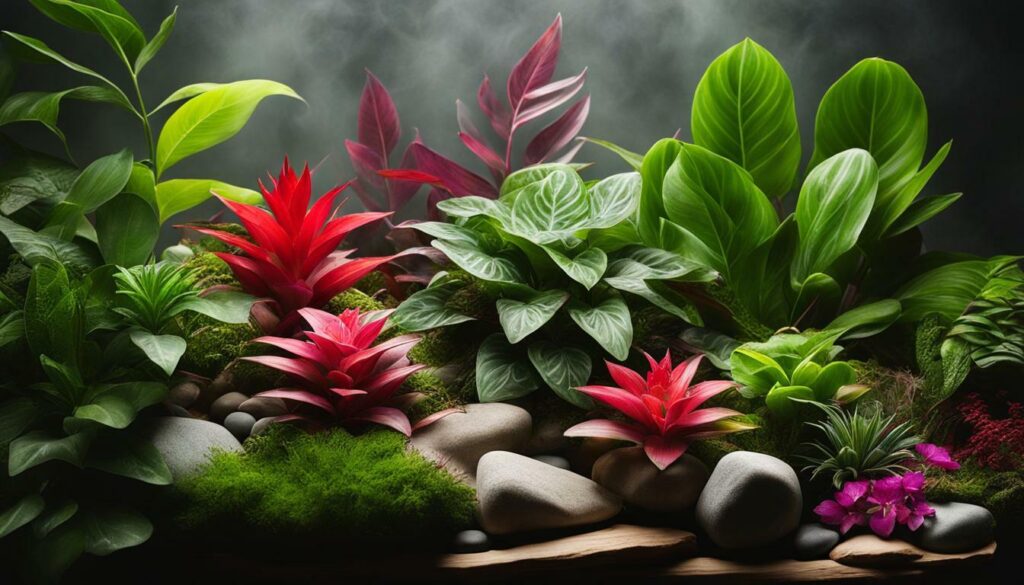
By incorporating prayer plants into your terrarium, you can create a lush and vibrant indoor garden. Remember to provide them with proper care, lighting, and ideal growing conditions to ensure their longevity and beauty. Experiment with different plant combinations to create a unique and personalized terrarium that brings joy and tranquility to your space.
Care Tips for Terrarium Plants Prayer Plants
The Maranta leuconeura, also known as the prayer plant, is a popular choice for terrariums. This tropical plant native to South America features stunning deep green foliage with rich purple undersides, adding a vibrant touch to any indoor garden. The leaves of the prayer plant fold up at night, resembling praying hands, which adds to its unique appeal.
When it comes to care, prayer plants thrive in medium to high light intensity, so it’s essential to place them in a well-lit area of your home. They grow to be around 6 to 12 inches in height, making them suitable for both foreground and background positions in a terrarium. For a visually pleasing arrangement, consider placing prayer plants along the edges and top of hardscapes, allowing their lush foliage to cascade over the edges.
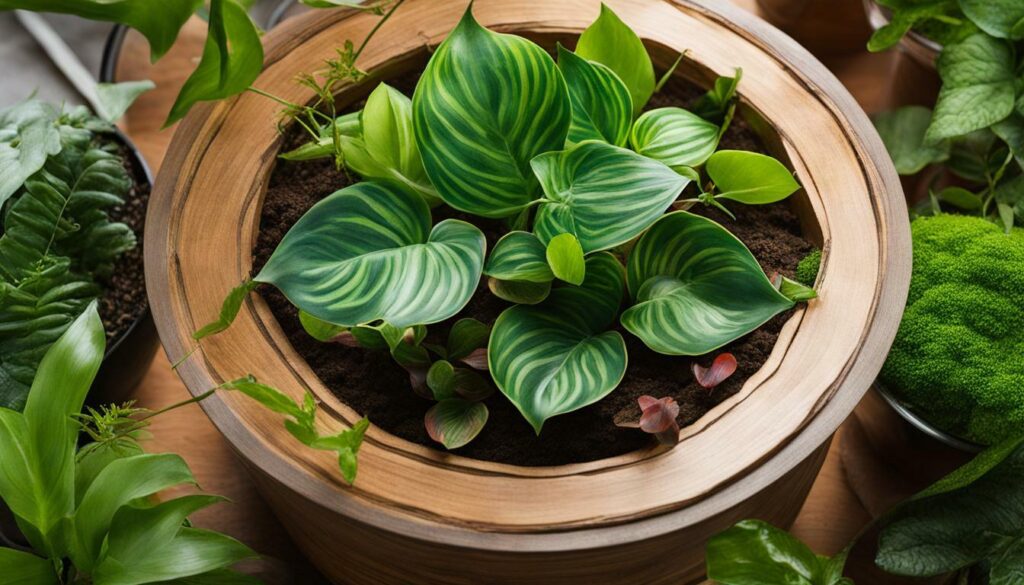
When watering prayer plants, it’s important to strike the right balance. Provide regular, moderate watering, ensuring the soil remains moist but not waterlogged. Overwatering can lead to root rot and other issues, so it’s crucial to allow the soil to dry out slightly between waterings. Additionally, maintaining a mildly acidic pH level in the soil will promote healthy growth.
If you’re looking for alternatives to prayer plants for your terrarium, consider ferns, foliage plants like Peperomia and Calathea, vines like Selaginella and Ficus pumila, or epiphytes like Tillandsia. These plants offer similar aesthetic appeal and thrive in terrarium environments. For beginners, Nerve Plant, Polka Dot Plant, and Pilea are easy-to-care-for options that will add beauty to your indoor garden. Open terrariums, on the other hand, are better suited for arid species like succulents and cacti, which require full sun and well-drained soil.
Alternatives to Terrarium Plants Prayer Plants
The Maranta leuconeura, also known as the prayer plant, is a popular choice for terrariums. This tropical plant native to South America features stunning deep green foliage with rich purple undersides, making it a visually appealing addition to any indoor garden. One of the unique characteristics of the prayer plant is that its leaves fold up at night, resembling praying hands, adding an interesting dynamic to its aesthetic appeal.
The prayer plant typically grows to a height of 6 to 12 inches and thrives in medium to high light intensity. When it comes to soil requirements, this plant prefers moist, well-drained soil with a slightly acidic pH level. In a terrarium setting, prayer plants can be used in both foreground and background positions, but they look best when placed along the edges and top of hardscapes. Their vibrant foliage adds a pop of color and interest to any terrarium arrangement.
If you’re looking for alternatives to prayer plants for your terrarium, there are several options to consider. Ferns are a popular choice, with their feathery fronds and variety of shapes and sizes. Foliage plants like Peperomia and Calathea also make excellent substitutes, as their unique leaf patterns and textures create visual interest. Vines such as Selaginella and Ficus pumila can provide trailing elements, adding depth to your terrarium design. Additionally, epiphytes like Tillandsia, also known as air plants, can add a touch of whimsy and require minimal maintenance.
| Alternatives to Terrarium Plants Prayer Plants | Light Requirements | Watering Needs |
|---|---|---|
| Ferns | Low to medium light | Moist soil |
| Peperomia | Low to medium light | Well-drained soil |
| Calathea | Medium to bright indirect light | Moist soil |
| Selaginella | Medium to high light | Moist soil |
| Ficus pumila | Medium to high light | Well-drained soil |
| Tillandsia | Bright indirect light | Minimal watering |
Remember, when selecting alternative plants for your terrarium, consider their light requirements and watering needs to ensure they thrive in their new environment. These substitutes can help you create a beautiful and diverse terrarium garden that suits your personal style and preferences.
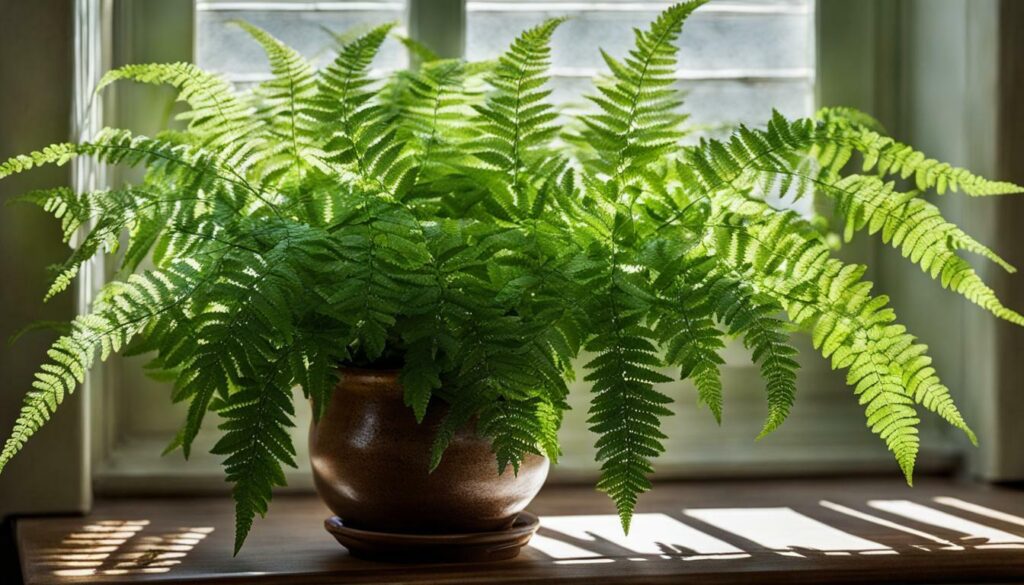
If you’re new to indoor gardening and looking to create a stunning terrarium, there are several beginner-friendly plant options that are perfect for your endeavor. One such option is the Nerve Plant (Fittonia spp.), which features vibrant leaves in shades of green, red, and pink. This compact plant thrives in humid environments and prefers medium to low light conditions.
The Polka Dot Plant (Hypoestes phyllostachya) is another excellent choice for beginners. This plant is known for its eye-catching foliage, which is adorned with splashes of color in shades of pink, red, or white. The Polka Dot Plant enjoys bright, indirect light and high humidity levels.
A third beginner-friendly option is the Pilea (Pilea peperomioides), also known as the Chinese money plant. This plant features unique, pancake-shaped leaves that add a touch of whimsy to any terrarium. Pilea thrives in bright, indirect light and well-draining soil.
| Terrarium Plants for Beginners |
|---|
| Nerve Plant (Fittonia spp.) |
| Polka Dot Plant (Hypoestes phyllostachya) |
| Pilea (Pilea peperomioides) |
These beginner-friendly terrarium plants are not only visually appealing but also relatively easy to care for. They can be grown in a variety of terrarium styles, from open containers to enclosed glass vessels. By choosing these plants, you can embark on your indoor gardening journey with confidence and create a beautiful terrarium that will thrive in your home.
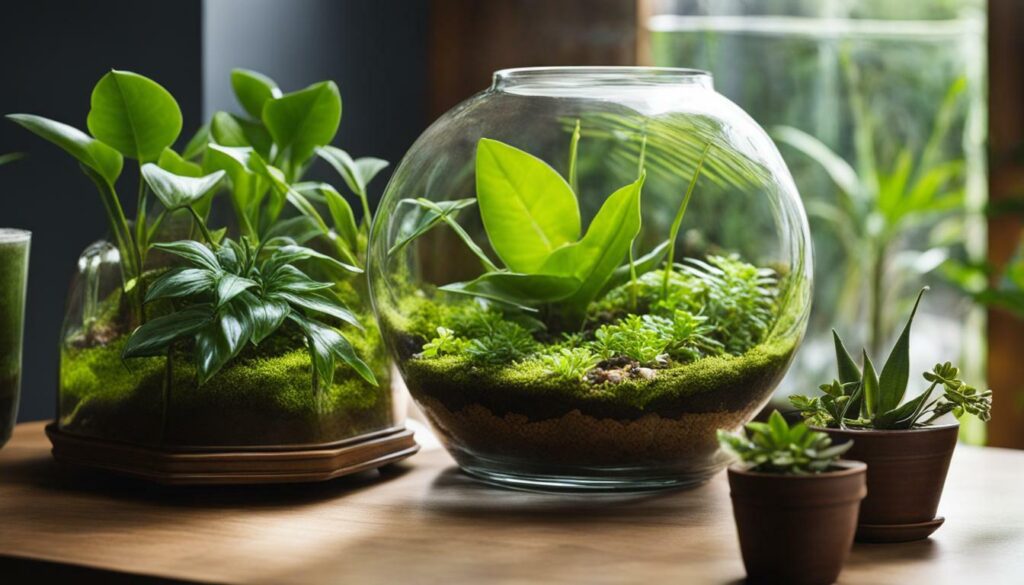
Open terrariums provide a unique opportunity to showcase arid species that thrive in low moisture and humidity environments. Succulents and cacti are excellent choices for open terrariums, adding a touch of natural beauty with their unique shapes and vibrant colors. These plants require full sun and well-drained soil, making them ideal for creating an eye-catching display in your indoor garden.
One popular open terrarium plant is the Maranta leuconeura, also known as the prayer plant. With its deep green foliage and rich purple undersides, it adds a striking element of beauty to any terrarium. The prayer plant grows to be around 6 to 12 inches in height and prefers medium to high light intensity. Its leaves fold up at night, resembling praying hands, adding a touch of elegance to your terrarium.
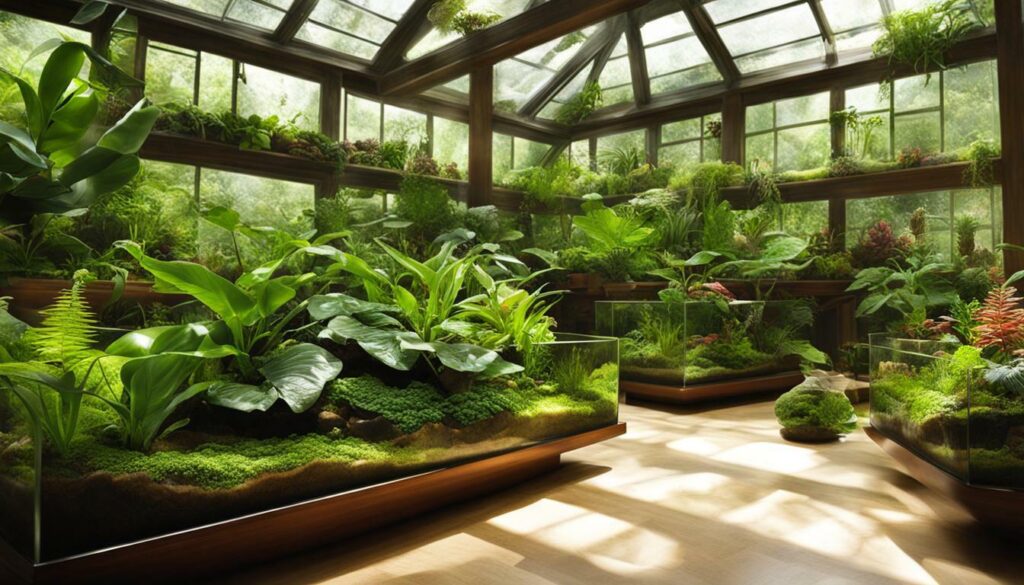
When incorporating open terrarium plants like succulents and cacti into your indoor garden, it’s important to provide the right conditions. These plants thrive in well-drained soil, so make sure to use a mix specifically formulated for succulents and cacti. As for light, they require full sun, so place your open terrarium in a bright spot near a window where they can receive direct sunlight for a few hours each day. Avoid overwatering by allowing the soil to dry out between waterings, as these plants are adapted to survive in dry conditions.
| Plant | Light Requirements | Watering Needs |
|---|---|---|
| Succulents | Full sun | Allow soil to dry out between waterings |
| Cacti | Full sun | Water sparingly, allow soil to dry out completely between waterings |
With their low maintenance requirements and stunning visual appeal, open terrarium plants like succulents and cacti are a great choice for adding a touch of desert beauty to your indoor garden. Experiment with different varieties and arrangements to create a captivating display that will be sure to impress.
Lighting Requirements for Terrarium Plants Prayer Plants
When it comes to terrarium plants, the Maranta leuconeura, commonly known as the prayer plant, is a popular choice for indoor gardening enthusiasts. This tropical plant native to South America boasts stunning deep green foliage with rich purple undersides, making it a visually appealing addition to any terrarium. One of its unique features is its ability to fold its leaves up at night, resembling praying hands. But what are the lighting requirements for these low light plants?
The prayer plant thrives in medium to high light intensity, making it ideal for terrariums placed in well-lit areas of your home. While it can tolerate low light conditions, providing it with bright, indirect light will help enhance its growth and vibrant colors. Placing your terrarium near a north or east-facing window is a great way to ensure the prayer plant receives adequate lighting throughout the day.
It is important to note that direct sunlight can scorch the leaves of the prayer plant, so it’s best to avoid placing the terrarium in direct sunlight. If you don’t have access to natural light, artificial grow lights can be used to provide the necessary light intensity for the prayer plant’s growth.
Overall, the prayer plant is a versatile and adaptable plant that can thrive in a range of lighting conditions. By providing it with the right amount of light, you can ensure its foliage remains vibrant and healthy, adding a touch of natural beauty to your indoor garden.
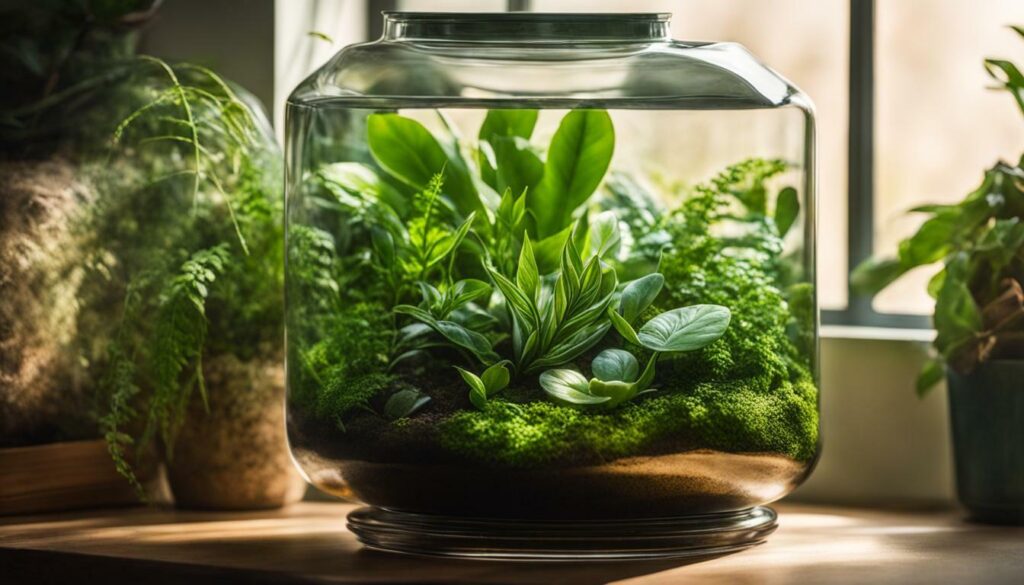
| Lighting Intensity | Location |
|---|---|
| Medium to high | Well-lit areas near north or east-facing windows |
| Low | Tolerates low light conditions but may exhibit slower growth |
| Direct sunlight | Avoid placing in direct sunlight to prevent leaf scorching |
| Artificial grow lights | If natural light is unavailable, use artificial grow lights to provide adequate lighting |
“The prayer plant is a versatile and adaptable plant that can thrive in a range of lighting conditions.”
Terrarium Plants Prayer Plant Varieties
The Maranta leuconeura, also known as the prayer plant, is a popular choice for terrariums. It is a tropical plant native to South America with stunning deep green foliage and rich purple undersides. The leaves of the prayer plant fold up at night, resembling praying hands. It grows to be around 6 to 12 inches in height and prefers medium to high light intensity. The plant thrives in moist, well-drained soil with a mildly acidic pH level.
There are several varieties of prayer plants, each with its unique features and characteristics. One popular variety is the Maranta leuconeura ‘Fascinator Tricolor,’ also known as the herringbone plant. It features striking leaves with intricate patterns of green, white, and red veins. Another variety is the Maranta leuconeura ‘Kerchoveana,’ which is known for its large, dark green leaves with white veins.
The Maranta leuconeura ‘Erythroneura’ is a variety that stands out with its bright red veins against dark green leaves. It creates a vibrant and eye-catching display in any terrarium. For those looking for a more compact variety, the Maranta leuconeura ‘Kim,’ also known as the rabbit track plant, is an excellent choice. Its compact growth habit and unique leaf patterns make it a standout addition to any indoor garden.
| Variety | Characteristics |
|---|---|
| Maranta leuconeura ‘Fascinator Tricolor’ | Striking leaves with green, white, and red veins |
| Maranta leuconeura ‘Kerchoveana’ | Large dark green leaves with white veins |
| Maranta leuconeura ‘Erythroneura’ | Bright red veins against dark green leaves |
| Maranta leuconeura ‘Kim’ | Compact growth habit with unique leaf patterns |
These prayer plant varieties offer a range of options for terrarium enthusiasts. From bold colors to intricate patterns, they add visual interest and beauty to any indoor garden. Consider these prayer plant varieties when selecting the perfect addition to your terrarium.
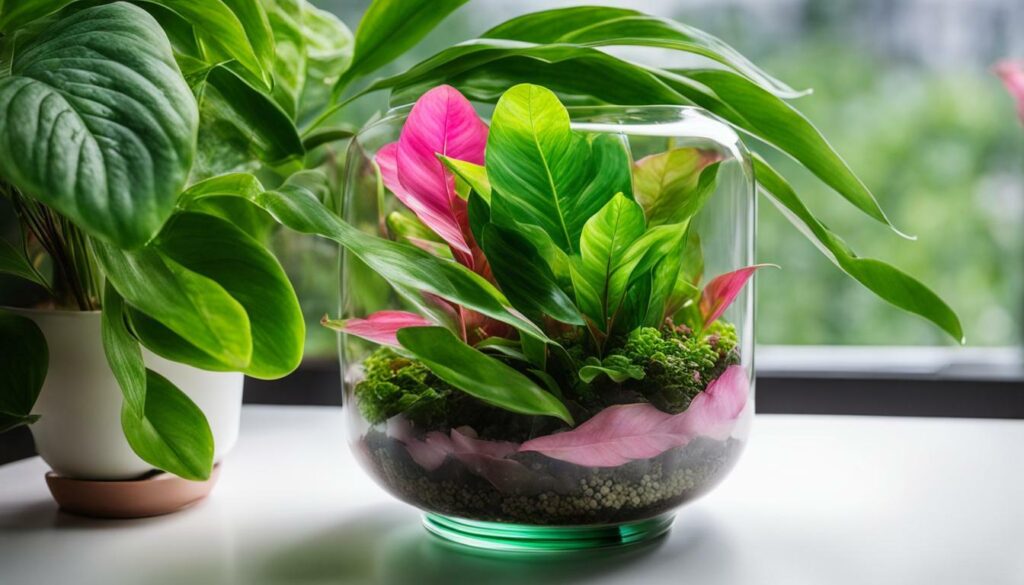
In summary, terrarium plants, particularly prayer plants, offer a vibrant and visually appealing addition to any indoor garden. The Maranta leuconeura, also known as the prayer plant, is a popular choice for terrariums due to its stunning deep green foliage and rich purple undersides. With its unique characteristic of folding leaves resembling praying hands, the prayer plant adds an element of elegance and intrigue to any terrarium.
When incorporating prayer plants into your indoor garden, it is important to provide the ideal growing conditions. These plants prefer medium to high light intensity and thrive in moist, well-drained soil with a mildly acidic pH level. To ensure their health and vitality, regular, moderate watering is recommended, while overwatering should be avoided.
While prayer plants are a fantastic choice for terrariums, there are also alternative options available. Ferns, foliage plants like Peperomia and Calathea, vines like Selaginella and Ficus pumila, and epiphytes like Tillandsia can be used as suitable replacements. Additionally, for those new to indoor gardening, terrarium plants such as Nerve Plant, Polka Dot Plant, and Pilea are beginner-friendly options to consider.
For open terrariums, arid species like succulents and cacti are ideal choices. These plants thrive in low moisture and humidity environments, requiring full sun and well-drained soil. When it comes to lighting, prayer plants and other terrarium plants can adapt to lower light conditions, making them versatile options for various indoor spaces.
In conclusion, incorporating terrarium plants, particularly prayer plants, into your indoor garden can bring beauty, vibrancy, and a touch of nature to your living space. By choosing the right plants, providing the proper growing conditions, and implementing appropriate care practices, you can create a captivating terrarium that will thrive and flourish for years to come.
What Are the Benefits of Growing Flowering Plants in a Terrarium Compared to Prayer Plants?
Growing flowering plants in a terrarium offers controlled conditions for optimal terrarium flowering plant care. Unlike prayer plants, terrariums provide a sealed environment that locks in moisture and creates high humidity. This helps to promote healthy growth and vibrant blooms, making it an ideal choice for plant enthusiasts.
FAQ
What are terrarium plants prayer plants?
Terrarium plants prayer plants, also known as prayer plants, are tropical plants native to South America. They are popular choices for indoor gardening and have stunning deep green foliage with rich purple undersides. The leaves of prayer plants fold up at night, resembling praying hands.
What are the growing conditions for terrarium plants prayer plants?
Terrarium plants prayer plants prefer medium to high light intensity and thrive in moist, well-drained soil with a mildly acidic pH level. They grow to be around 6 to 12 inches in height and require regular, moderate watering. It is important to avoid overwatering.
How can terrarium plants prayer plants be used in indoor gardens?
Terrarium plants prayer plants can be used in both foreground and background positions in a terrarium. They look best when placed along the edges and top of hardscapes, adding aesthetic appeal to your indoor garden.
What are the care tips for terrarium plants prayer plants?
When caring for terrarium plants prayer plants, it is important to provide regular, moderate watering and avoid overwatering. They thrive in a moderately humid environment. Maintaining appropriate humidity levels is crucial for their health.
Are there alternatives to terrarium plants prayer plants?
Yes, there are alternative plant options that can be used in place of prayer plants in terrariums. Some suitable alternatives include ferns, foliage plants like Peperomia and Calathea, vines like Selaginella and Ficus pumila, and epiphytes like Tillandsia.
What are some terrarium plants for beginners?
Nerve Plant, Polka Dot Plant, and Pilea are beginner-friendly terrarium plants that are easy to care for. They are suitable choices for those new to indoor gardening.
What kinds of plants are suitable for open terrariums?
Open terrarium plants are typically arid species that thrive in low moisture and humidity environments. Succulents and cacti are ideal choices for open terrariums as they require full sun and well-drained soil.
What are the lighting requirements for terrarium plants prayer plants?
Terrarium plants prayer plants are suitable for lower light conditions. They can thrive in medium to high light intensity but are also adaptable to lower light environments.
Are there different varieties of terrarium plants prayer plants?
Yes, there are different varieties of prayer plants, each with its own unique characteristics. These varieties can have variations in leaf color, shape, and size.

